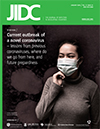Efficacy of infection control pathway in reducing postoperative infections in patients undergoing neurosurgery
DOI:
https://doi.org/10.3855/jidc.11747Keywords:
operating room, postoperative infection, infection control, air cleanlinessAbstract
Introduction: The environment of the operating room (OR) is closely related to the postoperative complications of patients, and it is necessary to study, to what extent, the stringent management of the OR can reduce postoperative complications.
Methodology: 426 patients who underwent surgery between January 2016 and December 2017 were selected from two class-100 laminar flow ORs of equivalent area, and were divided into an experimental group and a control group.
Results: The experimental group had significantly lower total air-borne bacterial count in the OR than the control group 10 minutes before surgery (6.21 ± 4.14 vs. 11.58 ± 5.36 CFU/cm3), 10 minutes (15.67 ± 6.21 vs. 20.83 ± 5.78 CFU/cm3), 30 minutes (27.34 ± 8.18 vs. 39.56 ± 7.86 CFU/cm3) and 60 minutes (43.62 ± 7.66 vs. 51.63 ± 8.43 CFU/cm3) into surgery, and at the end of surgery (57.34 ± 7.67 vs. 69.33 ± 9.41 CFU/cm3) (all p < 0.05). The incidence rates of increased body temperature and leukocyte count 3 days post-surgery, and the duration of antibiotic therapy and hospital stay were significantly reduced in the experimental group compared to the control group (all p < 0.05). Furthermore, the total number of pathogens in the incision at 2 hours into surgery was also significantly lower in the experimental group than in the control group (p < 0.05).
Conclusion: Stringent application of the infection control pathway is an efficacious measure for improving the air cleanliness of the neurosurgery OR, decreasing the incidence rates of postoperative complications and infection, as well as controlling pathogen transmission.
Downloads
Published
How to Cite
Issue
Section
License
Authors who publish with this journal agree to the following terms:
- Authors retain copyright and grant the journal right of first publication with the work simultaneously licensed under a Creative Commons Attribution License that allows others to share the work with an acknowledgement of the work's authorship and initial publication in this journal.
- Authors are able to enter into separate, additional contractual arrangements for the non-exclusive distribution of the journal's published version of the work (e.g., post it to an institutional repository or publish it in a book), with an acknowledgement of its initial publication in this journal.
- Authors are permitted and encouraged to post their work online (e.g., in institutional repositories or on their website) prior to and during the submission process, as it can lead to productive exchanges, as well as earlier and greater citation of published work (See The Effect of Open Access).








